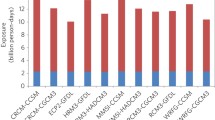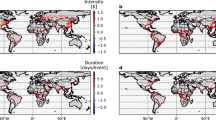Abstract
Heat waves are among the most dangerous climate-related hazards, and they are projected to increase in frequency and intensity over the coming century. Exposure to heat waves is a function of the spatial distribution of physical events and the corresponding population distribution, and future exposure will be impacted by changes in both distributions. Here, we project future exposure using ensembles of climate projections that account for the urban heat island effect, for two alternative emission scenarios (RCP4.5/RCP8.5) and two alternative population and urbanization (SSP3/SSP5) outcomes. We characterize exposure at the global, regional, and grid-cell level; estimate the exposure that would be avoided by mitigating future levels of climate change (to RCP4.5); and quantify the dependence of exposure on population outcomes. We find that climate change is a stronger determinant of exposure than demographic change in these scenarios, with a global reduction in exposure of over 50% under a lower emissions pathway, while a slower population growth pathway leads to roughly 30% less exposure. Exposure reduction varies at the regional level, but in almost all cases, the RCP remains more influential than the SSP. Uncertainty in outcomes is dominated by inter-annual variability in heat extremes (relative to variability across initial condition ensemble members). For some regions, this variability is large enough that a reduction in annual exposure is not guaranteed in each individual year by following the lower forcing pathway. Finally, we find that explicitly considering the urban heat island effect and separate urban and rural heat extremes and populations can substantially influence results, generally increasing projected exposure.



Similar content being viewed by others
Notes
Produced by scaling the present-day population distribution by projected change at the national level.
The most deadly extreme heat events of the past several decades have demonstrated maximum daily highs in exceedance of 40 °C for several consecutive days (e.g., India 2015; France/Europe 2003; Chicago/Midwestern US 1995) while daily mean temperatures hovered between the 32–36 °C range.
In North America, Europe, and Oceania, SSP3 represents the “low population growth” scenario, in all other regions it is SSP5.
References
Anderson GB, Bell ML (2011) Heat waves in the United States: mortality risk during heat waves and effect modification by heat wave characteristics in 43 US communities. Environ Health Perspect 119(2):210–218
Anderson GB, Oleson KW, Jones B, Peng RD (2016a) Classifying heatwaves: developing health-based models to predict high-mortality versus moderate United States heatwaves. Clim Chang. https://doi.org/10.1007/s10584-016-1776-0
Anderson GB, Oleson KW, Jones B, Peng RD (2016b) Projected trends in high-mortality heatwaves under different scenarios of climate, population, and adaptation in 82 US communities. Clim Chang. https://doi.org/10.1007/s10584-016-1779-x
Barnett AG, Tong S, Clements AC (2010) What measure of temperature is the best predictor of mortality? Environ Res 110:604–611
Basu R (2009) High ambient temperature and mortality: a review of epidemiologic studies from 2001 to 2008. Environ Health 8(40). https://doi.org/10.1186/1476-069X-8-40
Basu R, Ostro BD (2008) A multicounty analysis identifying the populations vulnerable to mortality associated with high ambient temperature in California. Am J Epidemiol 168(6):632–637
Collins M, Knutti R, Arblaster J et al (2013) Long-term climate change: projections, commitments and irreversibility. In: Stocker TF, Qin D, Plattner G-K et al (eds) Climate change 2013: the physical science basis. Contribution of Working Group I to the Fifth Assessment Report of the IPCC. Cambridge University Press, Cambridge, pp 1029–1136
Dong W, Liu Z, Liao H, Tang Q, Li XE (2015) New climate and socio-economic scenarios for assessing global human health challenges due to heat risk. Clim Chang 130(4):505–518
IPCC (2012) Managing the risks of extreme events and disasters to advance climate change adaptation. A special report of working groups I and II of the intergovernmental panel on climate change. In: Field CB, Barros V, Stocker TF et al (eds) . Cambridge University Press, Cambridge 582pp
Jiang L, O’Neill BC (2015) Global urbanization projections for the shared socioeconomic pathways. Glob Environ Chang. https://doi.org/10.1016/j.gloenvcha.2015.03.008
Jones B, O’Neill BC (2016) Spatially explicit global population scenarios consistent with the shared socioeconomic pathways. Environ Res Lett 11(8):084003
Jones C, Hughes J, Bellouin N et al (2011) The HadGEM2-ES implementation of CMIP5 centennial simulations. Geosci Model Dev 4:543–570
Jones B, O'Neill BC, McDaniel L, McGinnis S, Mearns LO, Tebaldi C (2015) Future population exposure to US heat extremes. Nat Clim Chang 5(7):652–655
Kay JE, Deser C, Phillips A et al (2014) The community earth system model (CESM) large ensemble project: a community resource for studying climate change in the presence of internal climate variability. Bull Am Meteorol Soc 96(8):1333–1349
Kc S, Lutz W (2014) The human core of the shared socioeconomic pathways: population scenarios by age, sex and level of education for all countries to 2100. Glob Environ Chang. https://doi.org/10.1016/j.gloenvcha.2014.06.004
Kharin VV, Zwiers FW, Zhang X, Wehner M (2013) Changes in temperature and precipitation extremes in the CMIP5 ensemble. Clim Chang 119:345–357
Li B, Sain S, Mearns LO et al (2012) The impact of extreme heat on morbidity in Milwaukee, Wisconsin. Clim Chang 110:959–976
Luber G, McGeehin M (2008) Climate change and extreme heat events. Am J Prev Med 35(5):429–435
O’Neill BC, Kriegler E, Ebi KL et al (2015) The roads ahead: narratives for shared socioeconomic pathways describing world futures in the 21st century. Glob Environ Chang. https://doi.org/10.1016/j.gloenvcha.2015.01.004
O’Neill BC, Done JM, Gettelman A et al (2017) The benefits of reduced anthropogenic climate changE (BRACE): a synthesis. Clim Chang. https://doi.org/10.1007/s10584-017-2009-x
Oleson KW, Anderson GB, Jones B et al (2015) Avoided climate impacts of urban and rural heat and cold waves over the U.S. using large climate model ensembles for RCP8.5 and RCP4.5. Clim Chang. https://doi.org/10.1007/s10584-015-1504-1
Sanderson BM, Oleson KW, Strand WG, O’Neill BC (2015) A new ensemble of GCM simulations to assess avoided impacts in a climate mitigation scenario. Clim Chang. https://doi.org/10.1007/s10584-015-1567-z
Smith KR, Woodward A, Campbell-Lendrum D et al (2014) Human health: impacts, adaptation, and co-benefits. In: Field CB, Barros V, Dokken DJ et al (eds) Climate change 2014: impacts, adaptation, and vulnerability. Part A: global and sectoral aspects. Contribution of Working Group II to the Fifth Assessment Report of the IPCC. Cambridge University Press, Cambridge, pp 709–754
Turner BL, Kasperson RE, Matson P et al (2003) A framework for vulnerability analysis in sustainability science. Proc Natl Acad Sci 100:8074–8079
van Vuuren D, Kriegler E, O’Neill BC et al (2014) A new scenario framework for climate change research: scenario matrix architecture. Clim Chang 122(3):373–386
Warszawski L, Frieler K, Huber V, Piontek F, Serdeczny O, Schewe J (2014) The Inter-Sectoral Impact Model Intercomparison Project (ISI–MIP): project framework. Proc Natl Acad Sci 111:3228–3232
Wilder M, Garfin G, Ganster P et al (2013) Climate change and U.S.-Mexico border communities. In: Garfin G, Jardine A, Merideth R et al (eds) Assessment of climate change in the Southwest United States: a report prepared for the National Climate Assessment. Island Press, Washington DC, pp 340–384
Acknowledgements
BJ was supported by the National Science Foundation (NSF) Science, Education, and Engineering for Sustainability (SEES) program, award CHE-1314040. CT acknowledges the support of the Regional and Global Climate Modeling Program (RGCM) of the U.S. Department of Energy’s, Office of Science (BER), Cooperative Agreement DE-FC02-97ER62402. This material is based upon work supported by the National Science Foundation (NSF) under Grant Number AGS-1243095. NCAR is sponsored by the NSF.
Author information
Authors and Affiliations
Corresponding author
Additional information
This article is part of a Special Issue on “Benefits of Reduced Anthropogenic Climate ChangE (BRACE)” edited by Brian O’Neill and Andrew Gettelman.
Electronic supplementary material
ESM 1
(DOCX 4234 kb)
Rights and permissions
About this article
Cite this article
Jones, B., Tebaldi, C., O’Neill, B.C. et al. Avoiding population exposure to heat-related extremes: demographic change vs climate change. Climatic Change 146, 423–437 (2018). https://doi.org/10.1007/s10584-017-2133-7
Received:
Accepted:
Published:
Issue Date:
DOI: https://doi.org/10.1007/s10584-017-2133-7




